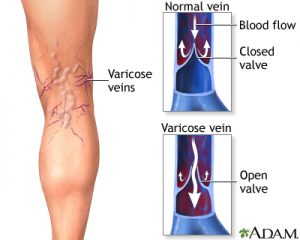A venous ulcer or varicose ulcer is an open sore which can be difficult to treat, and very slow to heal. Generally, venous ulcers appear around the ankle and they can take anywhere from weeks, to years, to completely disappear. For this reason, if you have varicose veins or circulation issues, you need to understand how venous ulcers form and how you can prevent them.
Venous ulcer causes
Venous ulcers that occur on the legs form due to chronic venous insufficiency. This is when the vein valves stop functioning properly due to weakness, scarring or blockage. Blood can start flowing backwards (refluxing) and pooling in the legs. Typically, this is how varicose veins and other vein disorders form.
In some patients, if chronic venous insufficiency is left untreated, it can irritate surrounding tissue, causing complications such as itching, inflammation, stasis dermatitis, or the painful wounds known as ulcers.
How do varicose ulcers form?
Several factors can cause venous ulcers. Here are the most common:
- Varicose veins: if you have varicose veins, your chances of developing stasis dermatitis are much higher. In short, varicose veins make it harder for oxygen-poor blood to travel to the heart, depriving the skin of the oxygen and nutrients it needs to stay healthy.
- DVT (deep vein thrombosis): a history of blood clots in the legs means you’re at risk of fluid build-up that can lead to venous ulcers.
- Genetics: family history can predispose you to weak veins.
- Hormonal factors: pregnancy, menstruation, and menopause all increase your chances of developing venous insufficiency and ulcers
- Old age: venous disorders are more common in older populations. Put simply, as we age, our skin and veins undergo natural wear and tear.
- Lifestyle factors: smoking, obesity and a sedentary lifestyle (prolonged sitting/standing) can cause venous insufficiency.
- Damage: in rare cases, an injury such as a burn or trauma to the muscle can cause venous ulcers.
Early and advanced signs/symptoms of venous ulcers
If you’re experiencing any of the symptoms below you should seek care from a qualified medical professional for a proper diagnosis and treatment:
- Inflamed swollen legs with heaviness and cramping.
- Itching, burning, pain and tingling sensation in the legs.
- Hardening or discolouration of the skin (dark red, purple, brown).
- Formation of superficial red-yellowish sores with uneven borders.
- Discomfort in the affected area – it may become shiny, tight or warm.
- Infection, foul odour and pus may be discharged from the ulcer.
How to prevent venous ulcers
If you have been diagnosed with venous insufficiency or varicose veins, you’re at risk for developing venous ulcers. So take the following precautions to promote good vein health and reduce your risk factors:
- Check your feet and legs every day: start at the top and move down to the ankles and feet. Be sure to take notice of any changes in colour and texture.
- Don’t smoke: smoking impairs blood circulation and damages your blood vessels. So if you’re a smoker, it’s time to think about quitting the habit.
- Eat healthily and exercise: a diet rich in antioxidants (fresh fruits and veggies) and staying active helps to promote good blood flow and improve vein health.
- Keep weight in the normal range: being overweight increases your risk of developing venous insufficiency, particularly varicose veins and ulcers.
- Manage diabetes: Keep your blood sugar under control to promote faster healing.
- Wear compression stocking: medical-grade compression stockings are specifically designed to prevent blood pooling in the lower legs. These stockings work by activating the muscles and squeezing the veins, helping blood get to the heart.
- Put your feet up: at the end of a long day prop your feet up on pillows to improve circulation and prevent blood stagnation.
- Treat your varicose veins: if a venous ulcer has developed due to varicose veins, you will need treatment. Unfortunately with varicose veins, although the symptoms can be managed, you’ll need treatment to seal the problem vein. Non-surgical, walk-in walk-out options such as Endovenous Laser are a safe and highly effective way to treat varicose veins. Find out more: Varicose Vein Treatments.
To read more about managing the symptoms of varicose veins: Non-Medical options for varicose veins.

Seek expert advice
The doctors at The Vein Institute specialise in varicose vein treatment. We offer patients a comprehensive treatment program to treat varicose veins, with non-surgical laser treatment techniques. The benefits of laser treatment to patients are:
- Walk-in walk-out treatment
- 98% success rate
- Extremely effective
- Can be performed at a clinic (no hospitalisation)
- No general anaesthetic
- Medicare rebates apply
- No downtime or time away from work
Call us on 0420 102 637, or fill out our booking request form.
